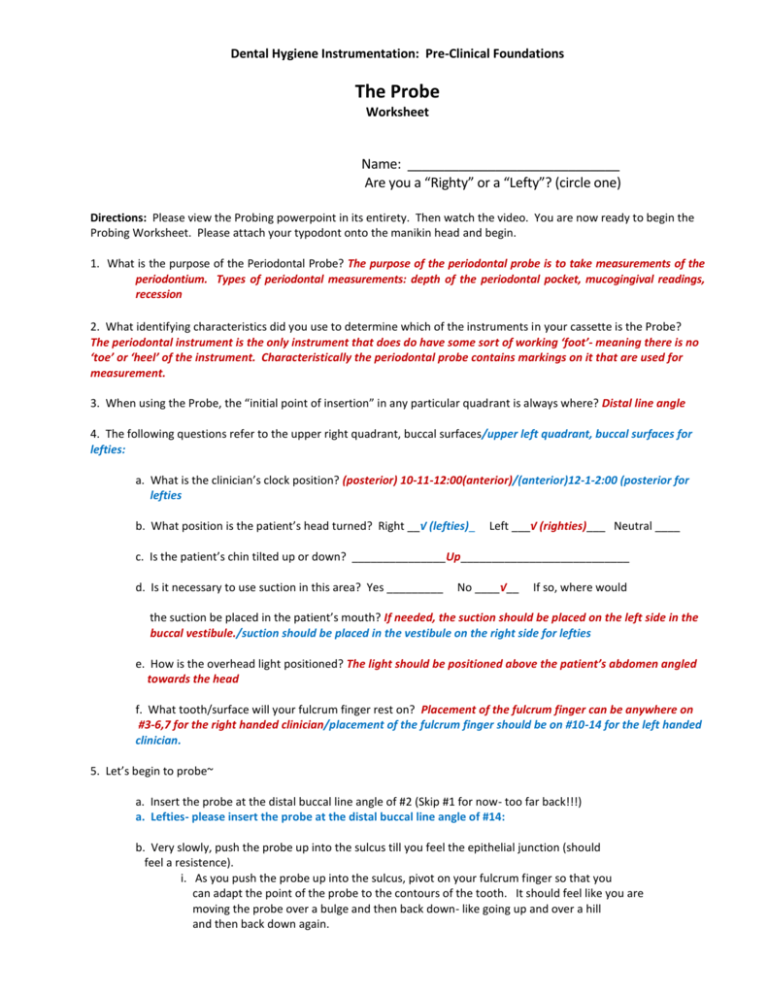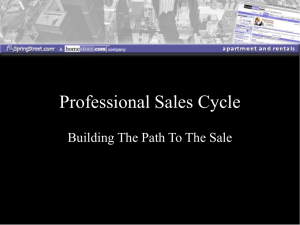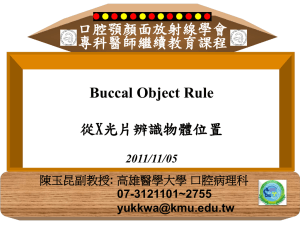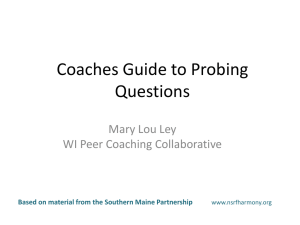Probing
advertisement

Dental Hygiene Instrumentation: Pre-Clinical Foundations The Probe Worksheet Name: _____________________________ Are you a “Righty” or a “Lefty”? (circle one) Directions: Please view the Probing powerpoint in its entirety. Then watch the video. You are now ready to begin the Probing Worksheet. Please attach your typodont onto the manikin head and begin. 1. What is the purpose of the Periodontal Probe? The purpose of the periodontal probe is to take measurements of the periodontium. Types of periodontal measurements: depth of the periodontal pocket, mucogingival readings, recession 2. What identifying characteristics did you use to determine which of the instruments in your cassette is the Probe? The periodontal instrument is the only instrument that does do have some sort of working ‘foot’- meaning there is no ‘toe’ or ‘heel’ of the instrument. Characteristically the periodontal probe contains markings on it that are used for measurement. 3. When using the Probe, the “initial point of insertion” in any particular quadrant is always where? Distal line angle 4. The following questions refer to the upper right quadrant, buccal surfaces/upper left quadrant, buccal surfaces for lefties: a. What is the clinician’s clock position? (posterior) 10-11-12:00(anterior)/(anterior)12-1-2:00 (posterior for lefties b. What position is the patient’s head turned? Right __√ (lefties)_ Left ___√ (righties)___ Neutral ____ c. Is the patient’s chin tilted up or down? _______________Up___________________________ d. Is it necessary to use suction in this area? Yes _________ No ____√__ If so, where would the suction be placed in the patient’s mouth? If needed, the suction should be placed on the left side in the buccal vestibule./suction should be placed in the vestibule on the right side for lefties e. How is the overhead light positioned? The light should be positioned above the patient’s abdomen angled towards the head f. What tooth/surface will your fulcrum finger rest on? Placement of the fulcrum finger can be anywhere on #3-6,7 for the right handed clinician/placement of the fulcrum finger should be on #10-14 for the left handed clinician. 5. Let’s begin to probe~ a. Insert the probe at the distal buccal line angle of #2 (Skip #1 for now- too far back!!!) a. Lefties- please insert the probe at the distal buccal line angle of #14: b. Very slowly, push the probe up into the sulcus till you feel the epithelial junction (should feel a resistence). i. As you push the probe up into the sulcus, pivot on your fulcrum finger so that you can adapt the point of the probe to the contours of the tooth. It should feel like you are moving the probe over a bulge and then back down- like going up and over a hill and then back down again. c. When you reach the epithelial junction- look at the readings on the probe- what is it? _____________ (Power point slides 24- 28 review How to Read the Probe) d. Pull out and move slightly more distal, reinsert into the sulcus and gently push apical till you reach the epithelial junction again. Take note of this new reading. e. Continue with this ‘bobbing’ stroke until the shank of the probe hits the contact point. f. Now, angle the probe so that the tip begins to move completely into the distal ‘col’ area. The probe shank should no longer look ‘parallel to the long axis of the tooth. (Power point slides #20- 22 review Probing into the Col area) ***Take note of the blue circle that appears on the video as the probe moves into the col area. g. Straighten the shank, without moving the tip, till the shank hits the contact point. Read this reading. h. What was the deepest reading on the distal surface? ___________________________________ i. Without pulling completely out, begin to ‘bob’ back out of the col towards the Distal Line angle. j. Continue past the line angle and ‘bob’ to the mesial line angle. Take note of your wrist, is pivoting on its fulcrum? Are your shoulders relaxed and down? What was the deepest reading? ____________________ k. Complete the last surface- Mesial, by ‘bobbing’ in and out of the sulcus until the shank of the probe reaches the contact point. Once again, angle tip towards the col and straighten shank up close to the contact point. What was the deepest reading? ________ l. Continue probing the rest of the teeth in the upper right quadrant (upper left for Lefties), recording distal surface readings first, then buccal and then mesial surfaces of each tooth before moving on to the next tooth. You should always begin with the most posterior tooth and move anterior. I. When you are comfortable with the technique, demonstrate probing of the Maxillary Right Quadrant, Buccal surfaces: Lefties- Left Quadrant, Buccal surfaces: Instructor initials: _____________________________ II. Complete probing the Maxillary Right Quad. LINGUAL surfaces, starting with the DL of #2 Maxillary Left Quad. Lingual for Lefties, starting with DL of #14 i. What is the clinician’s clock position? -_____11:00/1:00______ ii. Which way is the patient’s head turned? (√ one) iii. What type of vision are you using? (√ one) Right _ _√ (lefties)_ Left _√ (righties)_ Direct ________ Indirect ____√ _____ iv. Where is the suction? (√ one) Not in the patient’s mouth ___√ _ In the patient’s mouth ___ When you are comfortable with the technique, please demonstrate to faculty the Maxillary Right Quadrant Lingual surfaces:. Left Quadrant Lingual surfaces for Lefties: Instructor initials: ___________________ ~~~~~~~~~~~~~~~~~~~~~~~~~~~~~~~~~~~~~~~~~~~~~~~~~~~~~~~~~~~~~~~~~~~~~~~~~~~~~~~~ III. Complete probing the Maxillary Left Quad. Buccal surfaces starting with the DB of #15: Maxillary Right Quad. Buccal and for Lefties, starting with #2: i. What is the clinician’s clock position? ______________________11:00/1:00______ ii. Which way is the patient’s head turned? (√ one) Right ____√ (righties)___ Left ___√ (Lefties)__ iii. What type of vision are you using? (√ one) Direct _____√ __ Indirect ________ iv. Where is the suction ? (√ one) Not in the patient’s mouth __√ (don’t absolutely need it)_ In the patient’s mouth _____ When you are comfortable with the technique, demonstrate probing of the Maxillary Left Quadrant, Buccal surfaces: Maxillary Right Quad., Buccal surfaces for Lefties: Instructor initials: ______________________ IV. Complete probing the Maxillary Left Quad. Lingual surfaces starting with the DB of #15: Maxillary Right Quad. Lingual for Lefties, starting with #2: i. What is the clinician’s clock position? _______________________________________ ii. Which way is the patient’s head turned? (√ one) Right _√ (righties) iii. What type of vision are you using? (√ one) Left __√ (lefties)______ Direct ________ Indirect __√______ iv. Where is the suction ? (√ one) Not in the patient’s mouth ___√ (don’t absolutely need it)_ __ In the patient’s mouth __optional___ When you are comfortable with the technique, demonstrate probing of the Maxillary Left Quadrant, Lingual surfaces: Maxillary Right Quad., Lingual surfaces for Lefties: Instructor initials: ______________________ ~~~~~~~~~~~~~~~~~~~~~~~~~~~~~~~~~~~~~~~~~~~~~~~~~~~~~~~~~~~~~~~~~~~~~~~~~~~~~~~~ V. Complete probing the Mandibular Right Quad. Buccal surfaces starting with #31: i. What is the clinician’s clock position? ___10-11:00/1:00_____________________________ ii. Which way is the patient’s head turned? (√ one) iii. What type of vision are you using? (√ one) Right ________ Direct __√______ Left ___√___ Indirect __________ iv. Where is the suction ? (√ one) Not in the patient’s mouth ____ In the patient’s mouth _√ (left vestibule)__ When you are comfortable with the technique, demonstrate probing of the Mandibular Right Quadrant, Buccal surfaces: Instructor initials: _______________ VI. Complete probing the Mandibular Right Quad. Linguals surfaces starting with #31: i. What is the clinician’s clock position? ______11:00/1-2:00 (lefties ____________________ ii. Which way is the patient’s head turned? (√ one) iii. What type of vision are you using? (√ one) Right __√______ Direct _√_______ Left __________ Indirect __________ iv. Where is the suction ? (√ one) Not in the patient’s mouth ____ In the patient’s mouth _√ (right vestibule)__ When you are comfortable with the technique, demonstrate probing of the Mandibular Right Quadrant, Lingual surfaces: Instructor initials: _______________ ~~~~~~~~~~~~~~~~~~~~~~~~~~~~~~~~~~~~~~~~~~~~~~~~~~~~~~~~~~~~~~~~~~~~~~~~~~~~~~~~ VII. Complete probing the Mandibular Left Quad. Buccal surfaces starting with #18: i. What is the clinician’s clock position? 11:00/1:00 (lefties) ii. Which way is the patient’s head turned? (√ one) iii. What type of vision are you using? (√ one) Right ___√____ Direct __√______ Left __________ Indirect __________ iv. Where is the suction ? (√ one) Not in the patient’s mouth _ In the patient’s mouth __√ (right vestibule)____ When you are comfortable with the technique, demonstrate probing of the Mandibular Left Quadrant, Buccal surfaces: Instructor initials: _______________ VIII. Complete probing the Mandibular Left Quad. Lingual surfaces starting with #18: i. What is the clinician’s clock position? ___10-11:00/1-2:00 (lefties)_________________ ii. Which way is the patient’s head turned? (√ one) Right _ ______Left ___√___ iii. What type of vision are you using? (√ one) Direct _√ _______ Indirect __________ iv. Where is the suction? (√ one) Not in the patient’s mouth In the patient’s mouth √ (left vestibule)___ When you are comfortable with the technique, demonstrate probing of the Mandibular Left Quadrant, Lingual surfaces: Instructor initials: _______________








